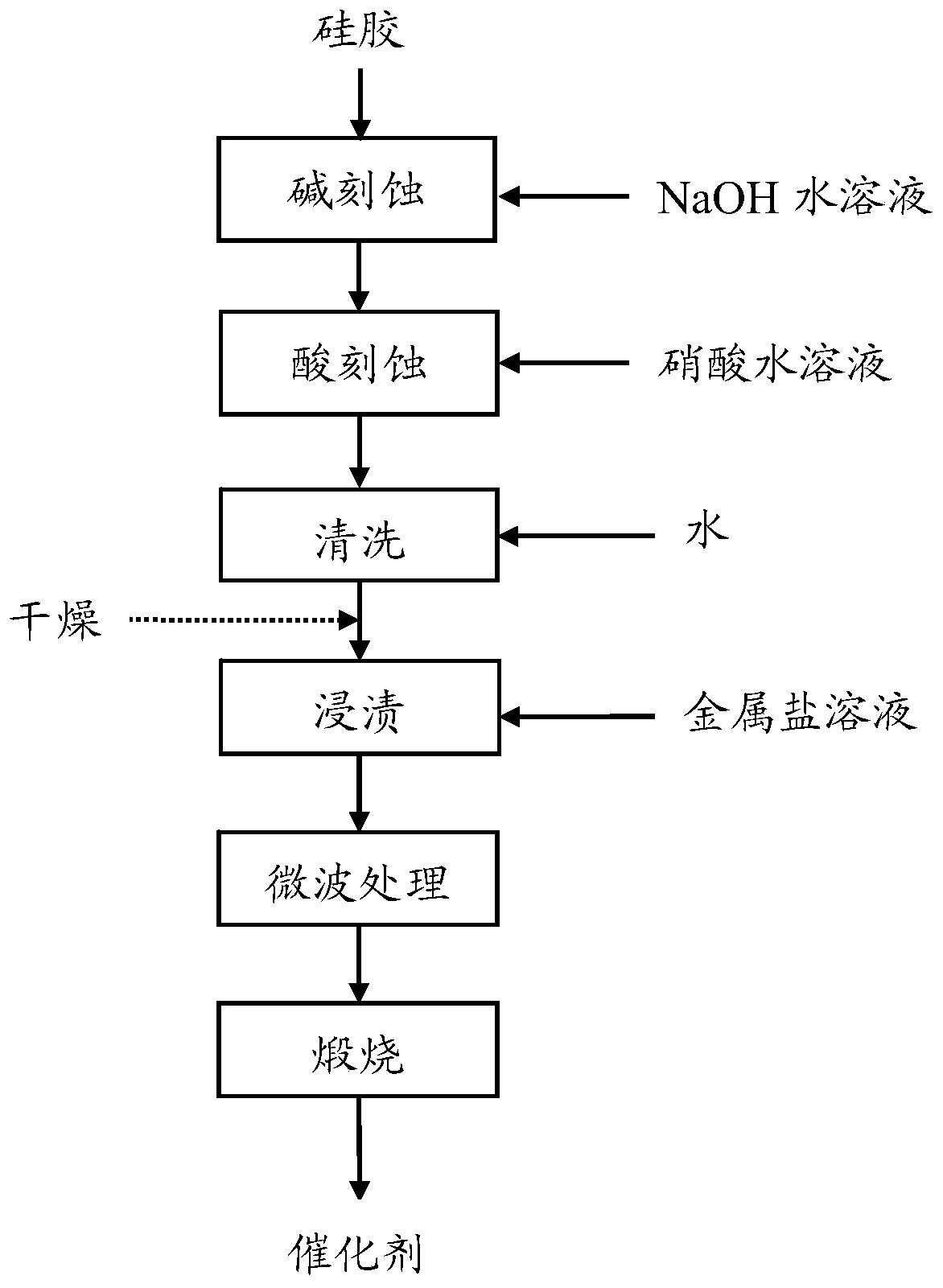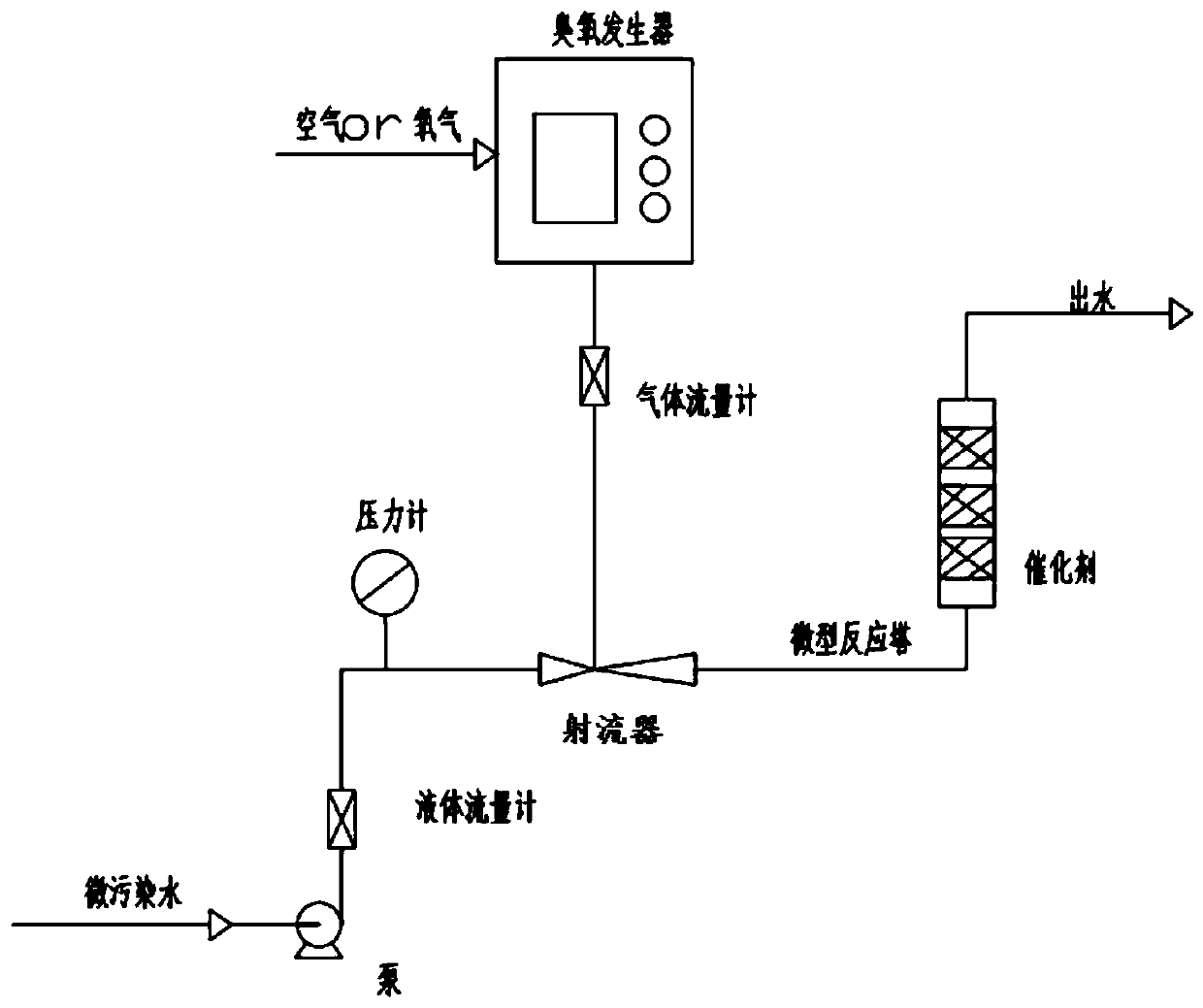A method for catalytic ozone oxidation to remove organic pollutants and synergistic bactericidal and antibacterial methods
A technology for organic pollutants and ozone oxidation, applied in the field of water treatment, to achieve good sterilization effect, fast speed, and low ozone concentration requirements
- Summary
- Abstract
- Description
- Claims
- Application Information
AI Technical Summary
Problems solved by technology
Method used
Image
Examples
Embodiment 1
[0035] (1) Pretreatment of B-type silica gel: B-type silica gel particles with a particle size of 1-2mm were washed with tap water, and dried in a constant temperature drying oven at 105°C. Soak 1kg of the cleaned type B silica gel with 8% NaOH aqueous solution for 2h, and then soak it with 8% dilute nitric acid solution for 2h to modify type B silica gel, and then wash it with tap water until neutral and dried at 105° C. to obtain a modified B-type silica gel carrier.
[0036] (2) Catalyst loading: immerse 1 kg of pretreated modified B-type silica gel carrier in a mixed solution of 1.2 times the volume of copper nitrate and manganese nitrate, wherein the mass fraction of copper nitrate is 1%, and the mass fraction of manganese nitrate is 1 %, mixed in a shaker for 24h, then filtered, treated with microwave radiation with a power of 800W and a frequency of 2450±50MHz for 20min, and then calcined in a muffle furnace at 500°C for 4h to obtain a catalyst.
[0037] (3) Catalytic ...
Embodiment 2
[0039] (1) Pretreatment of B-type silica gel: B-type silica gel particles with a particle size of 1-2mm were washed with tap water, and dried in a constant temperature drying oven at 105°C. Soak 1kg of the cleaned type B silica gel with 13% NaOH aqueous solution for 1h, and then soak it with 13% dilute nitric acid solution for 1h to modify type B silica gel, then wash with tap water until neutral and dried at 105° C. to obtain a modified B-type silica gel carrier.
[0040] (2) Catalyst loading: 1 kg of pretreated modified B-type silica gel carrier is immersed in 1.6 times the volume of copper nitrate and manganese nitrate mixed solution, wherein the mass fraction of copper nitrate is 2%, and the mass fraction of manganese nitrate is 4 %, mixed in a shaker for 12h, then filtered, treated with microwave radiation with a power of 800W and a frequency of 2450±50MHz for 20min, and then calcined in a muffle furnace at 500°C for 4h to obtain a catalyst.
[0041] (3) Catalytic ozone ...
Embodiment 3
[0043] (1) Pretreatment of B-type silica gel: B-type silica gel particles with a particle size of 3-5mm were washed with tap water, and dried in a constant temperature drying oven at 105°C. Soak 1kg of the cleaned type B silica gel with 10% NaOH aqueous solution for 2 hours, and then soak it with 10% dilute nitric acid solution for 2 hours to modify type B silica gel, and then wash it with tap water until neutral and dried at 105° C. to obtain a modified B-type silica gel carrier.
[0044] (2) Catalyst loading: immerse 1 kg of pretreated modified B-type silica gel carrier in 1.2 times the volume of copper nitrate, iron nitrate and manganese nitrate mixed solution, wherein the mass fraction of copper nitrate is 2%, the mass fraction of manganese nitrate The fraction is 4%, the mass fraction of iron nitrate is 4%, mixed in a shaker for 12h, then filtered, treated with microwave radiation with a power of 500W and a frequency of 2450±50MHz for 40min, and then calcined in a muffle ...
PUM
| Property | Measurement | Unit |
|---|---|---|
| particle size | aaaaa | aaaaa |
| pore size distribution | aaaaa | aaaaa |
| specific surface area | aaaaa | aaaaa |
Abstract
Description
Claims
Application Information
 Login to View More
Login to View More - R&D
- Intellectual Property
- Life Sciences
- Materials
- Tech Scout
- Unparalleled Data Quality
- Higher Quality Content
- 60% Fewer Hallucinations
Browse by: Latest US Patents, China's latest patents, Technical Efficacy Thesaurus, Application Domain, Technology Topic, Popular Technical Reports.
© 2025 PatSnap. All rights reserved.Legal|Privacy policy|Modern Slavery Act Transparency Statement|Sitemap|About US| Contact US: help@patsnap.com


